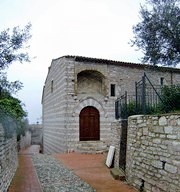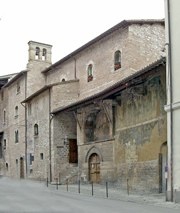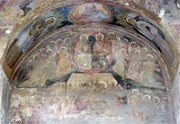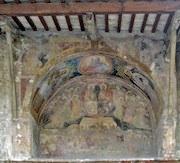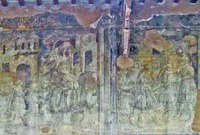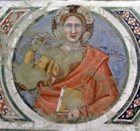

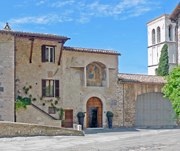
The oratory, which dates back to at least the 14th century, was first documented:
-
✴in 1424, when a document was notarised “ante maiestatem fraternitatis disciplinatorum s. Marie episcopatus” (in front of the Maestà of the Confraternity of Santa Maria del Vescovado); and
-
✴in 1426, when the “fraternitatis disciplinatorum s. Marie episcopatus sub vocabulo s. Blaxii nuncupata” (the Confraternity of Santa Maria del Vescovado, also called that of St Blaise) held a chapter meeting here.
This confraternity seems to have been formed by two originally separate organisations:
-
✴the Confraternity of Santa Maria del Vescovado or di Santa Maria Maggiore, which was first documented in 1354; and
-
✴the Confraterni di San Biaggio, whose patron was St Blaise, the patron saint of the wool workers who worked at nearby Fonte Moiano.
Bishop Nicolò Sermattei suppressed the confraternity in 1772. In 1790, Bishop Carlo Zangari transferred the oratory to the Confraternita dei SS Crispino e Crispiniano (Shoemakers’ Guild). which had no seat at that time.
The oratory was sold into private ownership in the early 20th century and is now a hotel, the Residenza d’ Epoca San Crispino.
Frescoes in the Aedicule (ca. 1330)

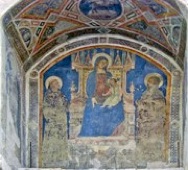

As noted above, the frescoes that survive in situ in the shrine above the portal of the oratory were documented in 1424. They are attributed to the Maestro di San Crispino. They depict:
-
✴the Madonna and Child enthroned with SS Francis and Clare and members of the confraternity, dressed in white robes;
-
✴the Lamb of God, above
-
✴St Blaise, holding the wool carding comb that was the instrument of his martyrdom, to the left; and
-
✴an unidentified saint, perhaps St John the Baptist, to the right.
There is a damaged fresco of St Christopher to the left of the shrine.
Art from the Oratory in the Pinacoteca
The following works from the oratory are in the Pinacoteca Comunale:
Crucifixion (early 14th century)
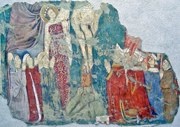
In this fragment of the lower part of a fresco of the Crucifixion, a female saint (probably St Elizabeth of Hungary) and two groups of devotees kneel at the foot of the Cross.
Frescoes (mid 14th century)
These frescoes from the refectory include:

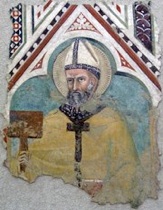
-
✴the autograph works of the so-called Maestro di San Crispino,
-
•St Onuphrius as a hermit, with a kneeling donor; and
-
•St Blaise with the instrument of his martyrdom (a wool carder’s comb);
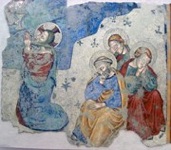
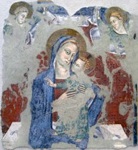
-
✴two works attributed to Pace di Bartolo:
-
•the agony in the garden; and
-
•a fragment of the Madonna and Child with angels;
-
✴God the Father (in very poor condition), by Matteo da Gualdo.
Processional Banner (ca. 1462)
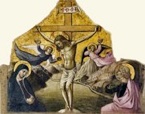
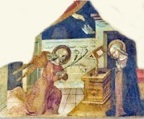
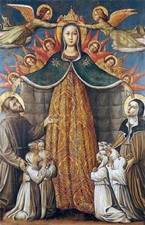
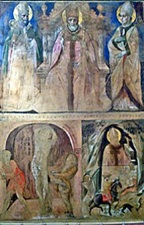
The two sides of this banner have been transferred onto separate canvases and are now in the Pinacoteca.
-
✴The main panel depicts the Madonna della Misericordia crowned by angels, with St Francis commending the sisters and St Clare the brothers of the confraternity.
-
✴Its reverse depicts St Blaise enthroned with SS Rufinus and Victorinus, above two scenes from the life of St Blaise:
-
•his flagellation (on the left); and
-
•his help to a pagan knight fleeing from persecution, whom he hid in his grotto.
This part of the banner was first documented in the oratory in 1859, when it served as an altarpiece: the second side was turned to the wall, which probably explains its poor state of preservation.
In 1912, the scholar Umberto Gnoli recognised a banner in the Musée des Beaux Arts, Angoulême as a twin of this banner in Assisi. It had been first documented in 1858 in the collection of the disgraced Roman, Giovanni Pietro Campana. This collection had been sold to the French government in 1863. The banner moved from Angoulême to the Musée du Petit Palais, Avignon in 1974.
The history of these banners probably goes back to 1462, when Giacomo di Bartoluccio left money in his will for a processional banner for the oratory. This presumably provided the funds for at least one of them. Each has been attributed to Nicolò di Liberatore, l' Alunno or his workshop throughout its documented history: most scholars hold that the banner in Assisi was a workshop copy of the one in Avignon, but some hold that the reverse is the case.
A double-sided panel in the Pinacoteca which depicts:
-
✴the Crucifixion with the Virgin and St John the Evangelist; and
-
✴the Annunciation,
can be associated with the banner there, albeit that it had been separated from the main panel by 1859: only the side depicting the Crucifixion was visible at that time, when it served as the upper part of the altarpiece on the main altar. The reconstruction illustrated above is based on the iconography of the banner in Avignon, which had passed into the Campanna collection in its entirety.
Other Art from the Oratory
Frescoes (mid 14th century)
These frescoes, which are attributed to the Maestro di San Crispino, are in the the Szépművészeti Múzeum (Museum of Fine Arts, Budapest). [Describe]
Ildikó Fehér, “Frescoes now in Budapest from the Confraternity of San Crispino, Assisi”, Arte Cristiana, 96 (May-June) (2008) 181-90
Processional Banner (ca. 1462)
This double-sided processional banner from the oratory, which is attributed to Nicolò di Liberatore, l' Alunno, is now in the Musée du Petit Palais, Avignon. For details, see the description above of its twin in the Pinacoteca Comunale.
St John's Apparition of the Virgin on Patmos (17th century)
This panel by Giacomo Giorgetti was documented in Oratorio di San Crispino in 1875. It was subsequently moved to Palazzo Vescovile and is now in the Museo Diocesano.
Read more:
Professors Francesco Santucci and Elvio Lunghi give more detailed accounts of the Oratorio di San Crispino and its frescoes in the website of the Residenza San Crispino.
Return to Oratories of Assisi.
Return to Monuments of Assisi.
Return to Walk II.
Return to the home page on Assisi.
